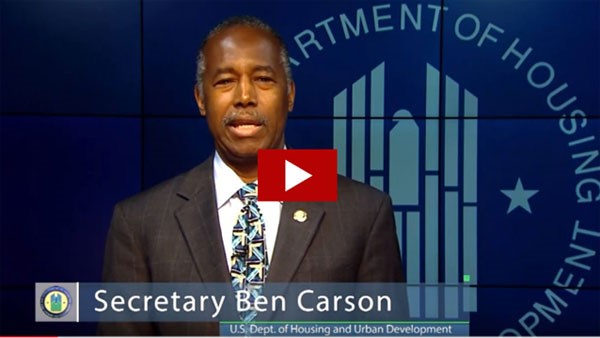Funding to identify and control potentially dangerous lead in thousands of homes with young children
The U.S. Department of Housing and Urban Development (HUD) today awarded $27.8 million to 38 Public Housing Agencies (PHAs) in 25 states to identify and reduce lead-based paint hazards in thousands of older public housing units. Provided through HUD’s Public Housing Capital Fund, these grants will be targeted to approximately 2,800 public housing units, most of which are currently occupied by families with young children (see below).
“We have no higher calling than to make certain the public housing that taxpayers support is healthy for our vulnerable families to live in,” said HUD Secretary Ben Carson. “As a doctor who treated many young children, I witnessed the close connection between health and housing. Today we make another critical investment in the futures of young children growing up in public housing.”
Although lead-based paint was banned for residential use in 1978, HUD estimates that about 24 million older homes still have significant lead-based paint hazards today. However, homes receiving rental assistance, including public housing, tend to have a lower prevalence of lead-based paint hazards compared to private housing. While most public housing has already undergone abatement, there are still some properties where lead-based paint remains and hazards have redeveloped.
Lead-contaminated dust is the primary cause of lead exposure and can lead to a variety of health problems in young children, including reduced IQ, learning disabilities, developmental delays, reduced height, and impaired hearing. At higher levels, lead can damage a child’s kidneys and central nervous system and can even be deadly.
In addition to the funding announced today, HUD will award a record $330 million later this year to clean up lead-based paint and other housing-related health and safety hazards in privately owned low-income housing. Click here or on this video to view Secretary Carson discuss the importance of HUD’s efforts to protect young children from lead.
In 2017, HUD published a new rule lowering the Department’s threshold of lead in the child’s blood to match the more protective guidance of the Centers for Disease Control and Prevention (CDC). This important change to HUD’s Lead Safe Housing Rule allows for a faster response if a young child is exposed to lead-based paint hazards in their HUD-assisted homes.
HUD has a long history of working to ensure lead-safe housing, which fits into the broader federal response to address lead hazards found in paint, dust and soil, and other sources like water and consumer goods. For 25 years, HUD’s Office of Lead Hazard Control and Healthy Homes has worked to improve methods to identify and address home-related health and safety hazards, including those from lead. Since 1993, HUD has awarded more than $2 billion in grants to communities for identification and control of lead-based paint hazards in over 200,000 low-income privately owned housing units. In addition, HUD supports research on best practices for identifying and controlling lead-based paint hazards and conducts an outreach program to get out the message.
| STATE | PUBLIC HOUSING AUTHORITY |
GRANT AMOUNT
|
| Alabama | Housing Authority of the City of Huntsville |
$1,000,000
|
| Housing Authority of the City of Heflin |
$340,000
|
|
| Housing Authority of Northport |
$1,000,000
|
|
| Alabama Total |
$2,340,000
|
|
| Arizona | City of Glendale Housing Authority |
$35,100
|
| California | Housing Authority of the County of Los Angeles |
$1,000,000
|
| Oakland Housing Authority |
$999,932
|
|
| Housing Authority City of Fresno |
$719,880
|
|
| California Total |
$2,719,812
|
|
| District of Columbia | D.C. Housing Authority |
$1,000,000
|
| Florida | Jacksonville Housing Authority |
$1,000,000
|
| Housing Authority of the City of Titusville |
$484,984
|
|
| Florida Total |
$1,484,984
|
|
| Georgia | Housing Authority of the City of LaGrange |
$1,000,000
|
| Illinois | Housing Authority of the City of East St. Louis |
$943,027
|
| Housing Authority of the County of Union |
$1,000,000
|
|
| Illinois Total |
$1,943,027
|
|
| Indiana | Housing Authority of the City of Elkhart |
$40,000
|
| Kansas | Kansas City, KS Housing Authority |
$519,960
|
| Maryland | Housing Authority of Baltimore City |
$898,750
|
| Housing Authority of the City of Cumberland |
$166,976
|
|
| Maryland Total |
$1,065,726
|
|
| Massachusetts | Springfield Housing Authority |
$146,125
|
| Michigan | Detroit Housing Commission |
$1,000,000
|
| Mississippi | Mississippi Regional Housing Authority No. VII |
$1,000,000
|
| Missouri | Housing Authority of the City of Independence |
$1,000,000
|
| Nebraska | Omaha Housing Authority |
$660,000
|
| New Jersey | Trenton Housing Authority |
$925,000
|
| Asbury Park Housing Authority |
$1,000,000
|
|
| New Jersey Total |
$1,925,000
|
|
| New Mexico | Housing Authority of the City of Gallup |
$1,000,000
|
| New York | Syracuse Housing Authority |
$161,500
|
| Utica Housing Authority |
$1,000,000
|
|
| White Plains Housing Authority |
$1,000,000
|
|
| New York Total |
$2,161,500
|
|
| North Carolina | Rocky Mount Housing Authority |
$1,000,000
|
| Ohio | Lucas Metropolitan Housing Authority |
$970,225
|
| Pennsylvania | Philadelphia Housing Authority |
$941,350
|
| Housing Authority of the City of Erie |
$1,000,000
|
|
| Bucks County Housing Authority |
$130,000
|
|
| Pennsylvania Total |
$2,071,350
|
|
| Rhode Island | Woonsocket Housing Authority |
$1,000,000
|
| Texas | Housing Authority of the City of Bryan |
$1,000,000
|
| Virginia | Chesapeake Redevelopment & Housing Authority |
$530,000
|
| Washington | Housing Authority City of Bellingham |
$60,000
|
| Housing Authority of Whatcom County |
$91,000
|
|
| Washington Total |
$151,000
|
|
| TOTAL |
$27,763,809
|
